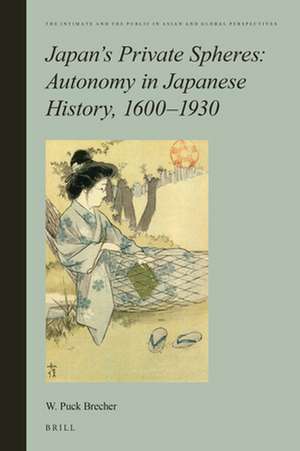Japan’s Private Spheres: Autonomy in Japanese History, 1600-1930: The Intimate and the Public in Asian and Global Perspectives, cartea 13
Autor William Puck Brecheren Limba Engleză Hardback – 31 mar 2021
Preț: 932.73 lei
Preț vechi: 1137.47 lei
-18% Nou
Puncte Express: 1399
Preț estimativ în valută:
178.50€ • 185.67$ • 147.36£
178.50€ • 185.67$ • 147.36£
Carte disponibilă
Livrare economică 25 martie-08 aprilie
Preluare comenzi: 021 569.72.76
Specificații
ISBN-13: 9789004447547
ISBN-10: 9004447547
Dimensiuni: 155 x 235 mm
Greutate: 0.7 kg
Editura: Brill
Colecția Brill
Seria The Intimate and the Public in Asian and Global Perspectives
ISBN-10: 9004447547
Dimensiuni: 155 x 235 mm
Greutate: 0.7 kg
Editura: Brill
Colecția Brill
Seria The Intimate and the Public in Asian and Global Perspectives
Cuprins
Acknowledgments
Figures and Tables
Keywords (キーワード)
Prologue
PART 1
Contextualizing the Private Sphere in Japanese History
1 Introduction
The Private “Problem”br/> 1 Contexts of Privacy in Modernizing Japan
2 Challenges and Methodologies
2 Public and Private in Pre-Meiji Thought and Society
1 Introduction
2 Public and Private in the Japanese Context
3 Public and Private in the Medieval Period
4 Public and Private in the Edo Period
3 The Private Self and the Meiji-Taisho State
1 The Individual’s Relationship to the State
2 Prescribed Private Spheres: Religion, the Home, and Leisure
3 Historiography on Modern Japan’s Private Spheres
PART 2
The Autonomous Self in the Edo Period (1600–1868)
4 Peripheries as Private Spheres
1 Everything in Its Place: City, Suburb, Countryside
2 Kōetsumura
3 Itami
3.1Itami Saké
3.2The Itami Salon
4 Negishi
4.1Negishi as a Homegrown Living Space
4.2Resignation and Reclusion
5Boyhood as an Autonomous Sphere
1 Introduction
2 Practical Childrearing
3 Diaries
4 Role Models and the Moral Authority of the Private
6“Publicizing” the Private
Self-Interrogation and Self-Indulgence in the Arts
1 Human Difference in Early Modern Thought
2 The Self-Interrogation of Hakuin (1685–1768) and Kinkoku (1761–1832)
3 Self and Self-Portraiture
4 Master Depravity and the Self as Spectacle
PART 3
Public and Private Selves in Meiji and Taisho (1868–1926)
7The Deviant in Meiji Society
Autonomy, Individuality, and Public Power
1 Meiji’s New Normal
2 Loser Literature
3 Anguished Art
4 Ideology and Rupture: Eccentricity and Its Place in Meiji’s Cultural Field
8The Private Individual in Early Meiji Education (1872–1890s)
1 The Individual in Early Meiji Education
2 On the Practice of Keeping Individuality Charts
3 Early Student Charts in the United States
4 Individuality as Control
9 Education and Public Individuality (1890s–1927)
1Kosei in Public Education
2 Changes in Student Evaluations
3Kosei as “Public Individuality”
PART 4
The Nationalization of Private Leisure (1868–1930s)
10Vacationing and Moral Authority
1 School Summer Vacations
2 Moral Authority and Vacationing for Adults
3 Ambivalence and Contestation
11 Nationalizing the Body
Physical Exercise as a Public Ethic
1 “Civilizing” the Physical Body
2 Western Athletics
3 Public Fitness as Statecraft (1920s~)
12 Conclusion
Can Modern Japan’s Private Spheres Be Moral?
1 Reconciliations of Self and State
Epilogue
Bibliography
Index
Figures and Tables
Keywords (キーワード)
Prologue
PART 1
Contextualizing the Private Sphere in Japanese History
1 Introduction
The Private “Problem”br/> 1 Contexts of Privacy in Modernizing Japan
2 Challenges and Methodologies
2 Public and Private in Pre-Meiji Thought and Society
1 Introduction
2 Public and Private in the Japanese Context
3 Public and Private in the Medieval Period
4 Public and Private in the Edo Period
3 The Private Self and the Meiji-Taisho State
1 The Individual’s Relationship to the State
2 Prescribed Private Spheres: Religion, the Home, and Leisure
3 Historiography on Modern Japan’s Private Spheres
PART 2
The Autonomous Self in the Edo Period (1600–1868)
4 Peripheries as Private Spheres
1 Everything in Its Place: City, Suburb, Countryside
2 Kōetsumura
3 Itami
3.1Itami Saké
3.2The Itami Salon
4 Negishi
4.1Negishi as a Homegrown Living Space
4.2Resignation and Reclusion
5Boyhood as an Autonomous Sphere
1 Introduction
2 Practical Childrearing
3 Diaries
4 Role Models and the Moral Authority of the Private
6“Publicizing” the Private
Self-Interrogation and Self-Indulgence in the Arts
1 Human Difference in Early Modern Thought
2 The Self-Interrogation of Hakuin (1685–1768) and Kinkoku (1761–1832)
3 Self and Self-Portraiture
4 Master Depravity and the Self as Spectacle
PART 3
Public and Private Selves in Meiji and Taisho (1868–1926)
7The Deviant in Meiji Society
Autonomy, Individuality, and Public Power
1 Meiji’s New Normal
2 Loser Literature
3 Anguished Art
4 Ideology and Rupture: Eccentricity and Its Place in Meiji’s Cultural Field
8The Private Individual in Early Meiji Education (1872–1890s)
1 The Individual in Early Meiji Education
2 On the Practice of Keeping Individuality Charts
3 Early Student Charts in the United States
4 Individuality as Control
9 Education and Public Individuality (1890s–1927)
1Kosei in Public Education
2 Changes in Student Evaluations
3Kosei as “Public Individuality”
PART 4
The Nationalization of Private Leisure (1868–1930s)
10Vacationing and Moral Authority
1 School Summer Vacations
2 Moral Authority and Vacationing for Adults
3 Ambivalence and Contestation
11 Nationalizing the Body
Physical Exercise as a Public Ethic
1 “Civilizing” the Physical Body
2 Western Athletics
3 Public Fitness as Statecraft (1920s~)
12 Conclusion
Can Modern Japan’s Private Spheres Be Moral?
1 Reconciliations of Self and State
Epilogue
Bibliography
Index
Notă biografică
W. Puck Brecher (Ph.D., University of Southern California, 2005) is Professor of Japanese History at Washington State University. He has authored three monographs and numerous articles on early modern and modern Japanese cultural history.











